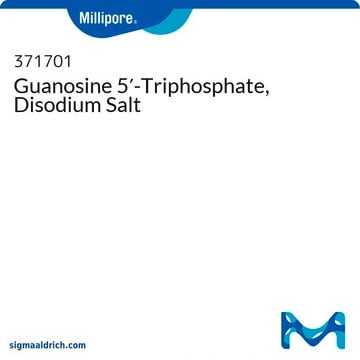G5884
Guanosine 5′-triphosphate lithium salt
~95% (HPLC), powder
Synonym(s):
GTP lithium salt
About This Item
Recommended Products
assay
~95% (HPLC)
form
powder
color
white
solubility
H2O: 100 mg/mL
shipped in
dry ice
storage temp.
−20°C
SMILES string
[Li+].NC1=Nc2c(ncn2[C@@H]3O[C@H](COP(O)(=O)OP(O)(=O)OP(O)([O-])=O)[C@@H](O)[C@H]3O)C(=O)N1
InChI
1S/C10H16N5O14P3.Li/c11-10-13-7-4(8(18)14-10)12-2-15(7)9-6(17)5(16)3(27-9)1-26-31(22,23)29-32(24,25)28-30(19,20)21;/h2-3,5-6,9,16-17H,1H2,(H,22,23)(H,24,25)(H2,19,20,21)(H3,11,13,14,18);/q;+1/p-1/t3-,5-,6-,9-;/m1./s1
InChI key
WDCLDKGIVWUKSE-GWTDSMLYSA-M
Looking for similar products? Visit Product Comparison Guide
Application
- In ribosome activity assay.
- In tubulin isolation and polymerization.
- In the determination of cell viability.
Biochem/physiol Actions
Features and Benefits
Caution
Preparation Note
signalword
Warning
hcodes
Hazard Classifications
Eye Irrit. 2 - Skin Irrit. 2 - STOT SE 3
target_organs
Respiratory system
Storage Class
11 - Combustible Solids
wgk_germany
WGK 3
flash_point_f
Not applicable
flash_point_c
Not applicable
ppe
dust mask type N95 (US), Eyeshields, Gloves
Certificates of Analysis (COA)
Search for Certificates of Analysis (COA) by entering the products Lot/Batch Number. Lot and Batch Numbers can be found on a product’s label following the words ‘Lot’ or ‘Batch’.
Already Own This Product?
Find documentation for the products that you have recently purchased in the Document Library.
Customers Also Viewed
Articles
Cyclic nucleotides like cAMP modulate cell function via PKA activation and ion channels.
Our team of scientists has experience in all areas of research including Life Science, Material Science, Chemical Synthesis, Chromatography, Analytical and many others.
Contact Technical Service








![Guanosine 5′-[β-thio]diphosphate trilithium salt ≥85% (HPLC), powder](/deepweb/assets/sigmaaldrich/product/structures/155/734/9bd8c8c5-4388-4f95-a924-4ff058fa4f41/640/9bd8c8c5-4388-4f95-a924-4ff058fa4f41.png)

![Guanosine 5′-[β,γ-imido]triphosphate trisodium salt hydrate ≥85% (HPLC), powder](/deepweb/assets/sigmaaldrich/product/structures/204/494/05808804-1ca7-44bf-b6c5-d4934dc7cb85/640/05808804-1ca7-44bf-b6c5-d4934dc7cb85.png)


